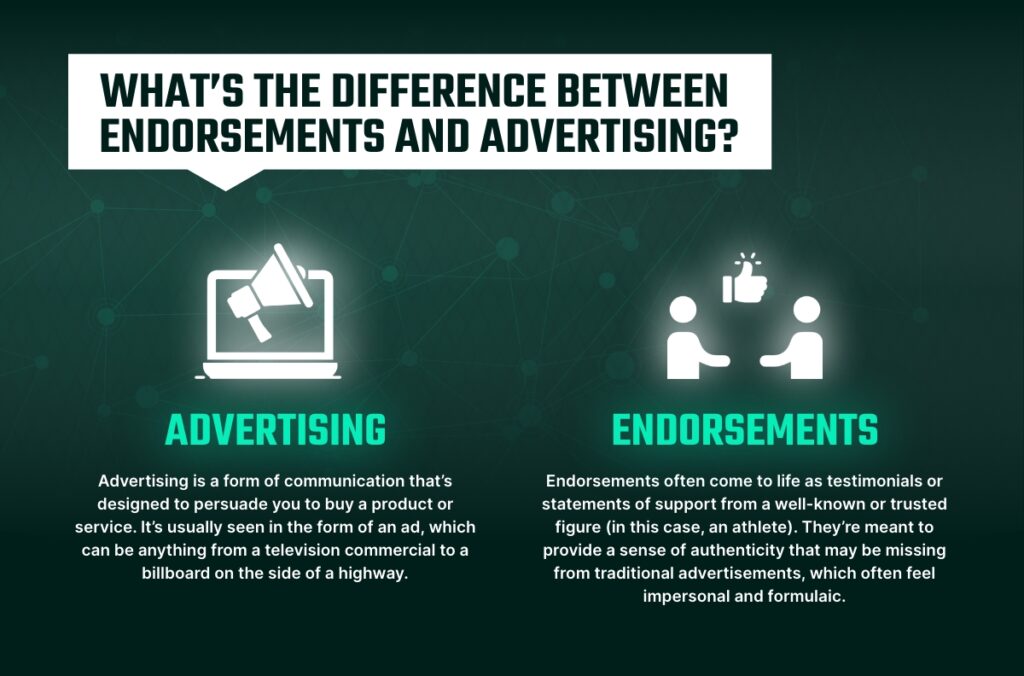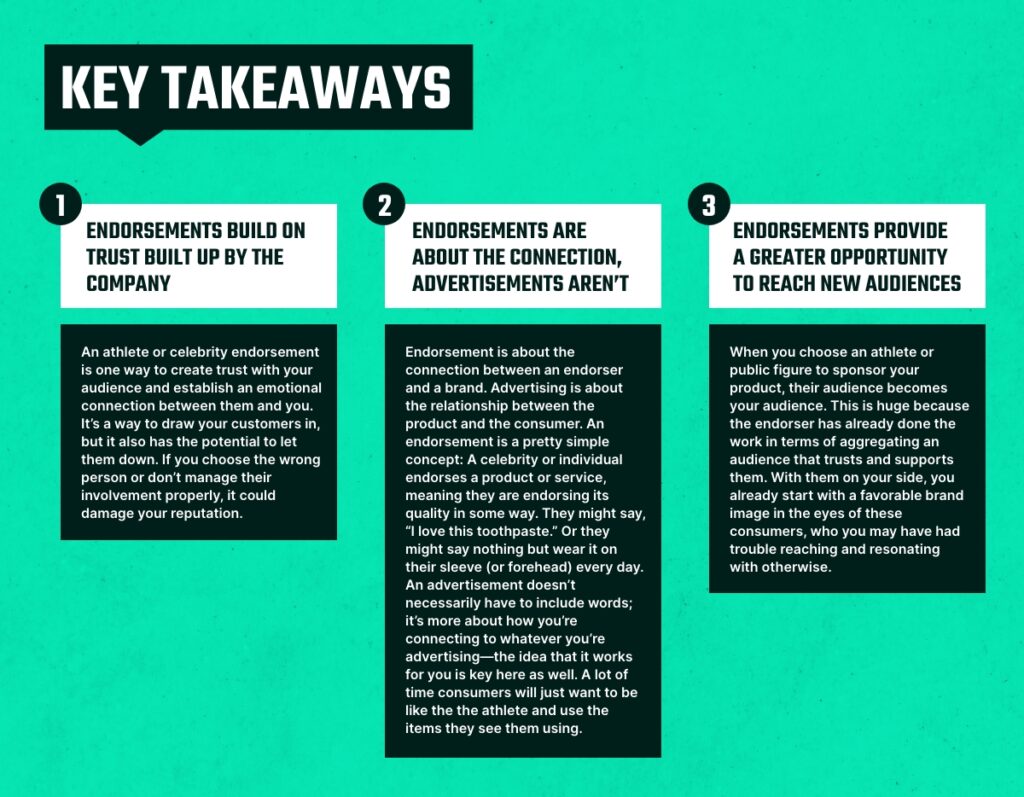From a business perspective, understanding the ins and outs of athlete endorsements can drastically improve how you approach them and recruit athlete influencers to represent your brand. Let’s start by addressing a common question: What’s the difference between endorsement and advertising?
Advertising and endorsements have been around for decades, but many people still have a hard time understanding the differences between the two. Although the terms have been used interchangeably—and both advertising and endorsements are used to market products and services—their differences lie in the message that’s being conveyed about the product or service being sold.

Advertising is a form of communication that’s designed to persuade you to buy a product or service. It’s usually seen in the form of an ad, which can be anything from a television commercial to a billboard on the side of a highway.
There are lots of different types of advertising, like direct response and brand awareness, for example. But all advertisements have one thing in common: they’re designed to persuade you to buy something. Advertisements are typically very action-based, ripe with calls to action and information on where you can go to get a product or service.
The types of messages you would expect to see in advertising include:

Here’s the thing, though—they’re not overly personal. Advertisements are often mass-distributed with the hope that they will land with the right audience. Endorsements and sponsorships offer a slightly different approach.
Endorsements fall under the umbrella of advertising/marketing, but they are unique in their own right. Endorsements often come to life as testimonials or statements of support from a well-known or trusted figure (in this case, an athlete). They’re meant to provide a sense of authenticity that may be missing from traditional advertisements, which often feel impersonal and formulaic.
Endorsements often lean into the connection between the company and the athlete or celebrity. If a company hires a celebrity to endorse its product, it’s usually because that individual’s profession or personal style aligns with their brand or product (this is why celebrity fashion campaigns work so well). The goal is for this positive association to rub off on the brand itself. When you see your favorite actor wearing something from Gucci or Chanel and looking cool doing so, you think “I’d like to emulate that figure” You associate those feelings with these brands—and if you shop at Nordstrom Rack one day and see an item that reminds you of something Brad Pitt wore in public? Suddenly shopping there seems like a better idea than shopping elsewhere!
The difference between an endorsement and an advertisement is the relationship it creates between the brand and the consumer. In a typical advertisement, there is no personal connection between the brand and its viewers; it’s simply a one-way street. An endorsement, however, relies on this two-way relationship: The consumer connects with the celebrity or influencer in some way. Endorsements focus on how you feel about someone else’s opinion of something—they’re about your trust in that person’s opinion because they have shared something similar before (or at least appear to be trustworthy). Advertisements don’t create this kind of bond between consumers and brands because they are solely focused on selling products without as much thought behind them beyond generating sales.
Endorsements and advertising are both powerful tools that can help you to build trust in your company, grow your audience and increase sales. Your approach to marketing your product will be largely dependent upon your goals. Are you trying to build brand awareness? Are you looking to reach new audiences? Is this just a big push for sales? The components of your advertising mix should work together to create a cohesive message that will resonate with your audience in a way that moves you closer to your goals.
In the end, it all comes down to knowing what motivates people—and using that knowledge in your marketing strategy.
If you’re curious about how to tell the difference between a sponsored Instagram post and an endorsement, consider these guidelines:
An athlete or celebrity endorsement is one way to create trust with your audience and establish an emotional connection between them and you. It’s a way to draw your customers in, but it also has the potential to let them down. If you choose the wrong person or don’t manage their involvement properly, it could damage your reputation.
Endorsement is about the connection between an endorser and a brand. Advertising is about the relationship between the product and the consumer. An endorsement is a pretty simple concept: A celebrity or individual endorses a product or service, meaning they are endorsing its quality in some way. They might say, “I love this toothpaste.” Or they might say nothing but wear it on their sleeve (or forehead) every day. An advertisement doesn’t necessarily have to include words; it’s more about how you’re connecting to whatever you’re advertising—the idea that it works for you is key here as well. A lot of time consumers will just want to be like the the athlete and use the items they see them using.
When you choose an athlete or public figure to sponsor your product, their audience becomes your audience. This is huge because the endorser has already done the work in terms of aggregating an audience that trusts and supports them. With them on your side, you already start with a favorable brand image in the eyes of these consumers, who you may have had trouble reaching and resonating with otherwise.

Athlete endorsements are a great way to build trust and credibility with consumers. Advertisements, on the other hand, are more about selling a product or service. When you’re trying to decide whether you should use an endorsement or another form of advertisement, think about what your goal is. If it’s to sell something, then go for an ad-based campaign. If it’s building confidence in your brand, then consider an endorsement from someone else who uses the same product or service as you do.You can search for athletes to create the perfect brand endorsement right here on Icon Source. Create an account today to start browsing athletes.